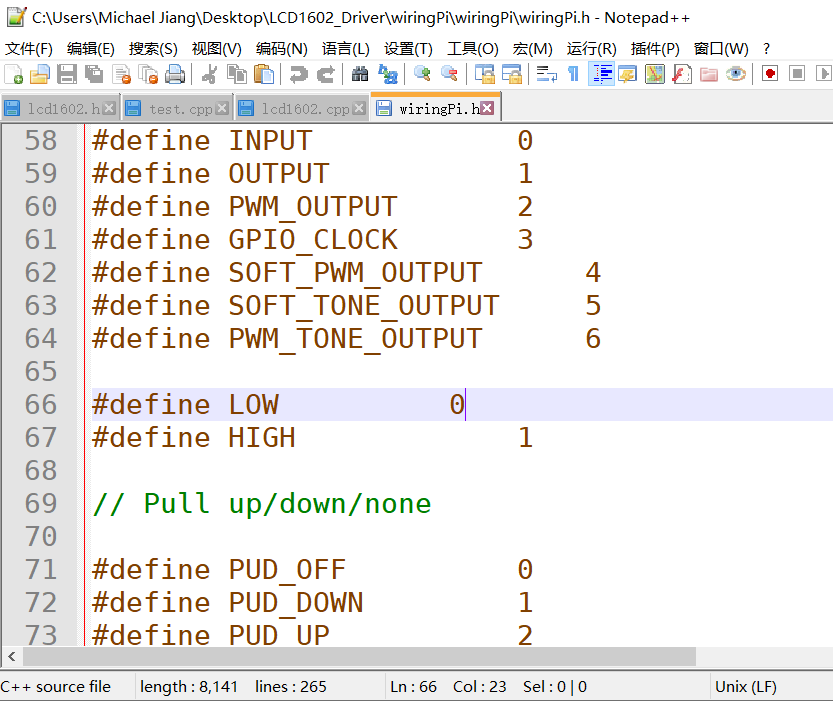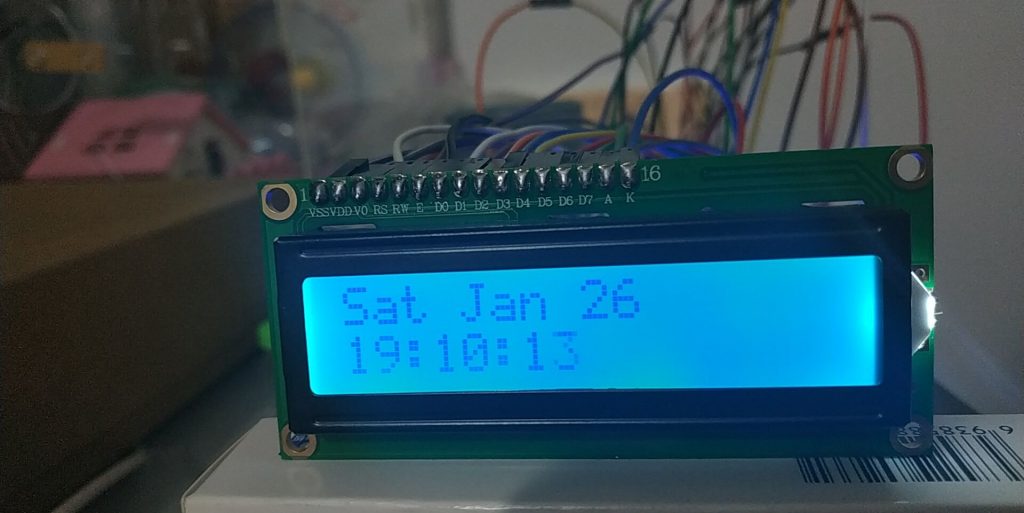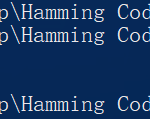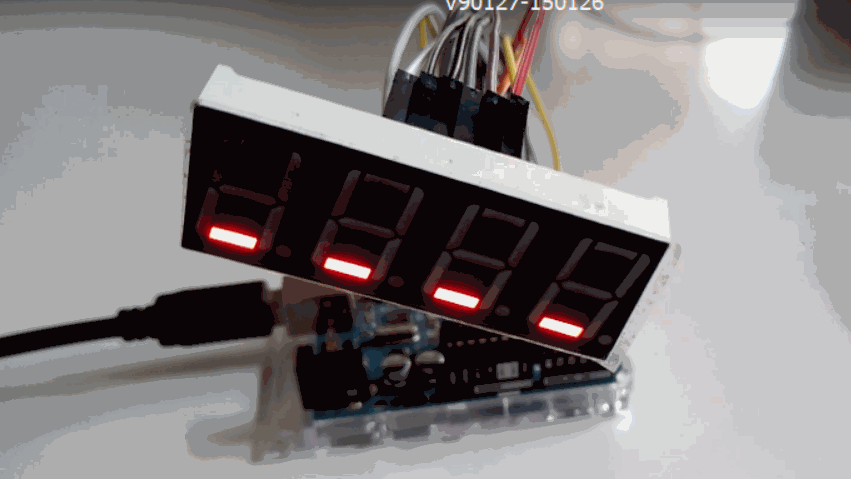LCD1602 Driver For Raspberry Pi 3
树莓派3b的Lcd1602驱动,基于wiringPi编写。
目前仅实现基础功能。
lcd1602.h
/*
// This file is part of LCD1602 Driver project
// Last-Modified:2019-1-26 16:54:33 @ V0.0.1
// Copyright (C)2019 SENCOM <sencom1997@outlook.com>
//
// This program is free software; you can redistribute it and/or
// modify it under the terms of the GNU General Public License
// as published by the Free Software Foundation; either
// version 3 of the License, or (at your option) any later version.
//
// This program is distributed in the hope that it will be useful,
// but WITHOUT ANY WARRANTY; without even the implied warranty of
// MERCHANTABILITY or FITNESS FOR A PARTICULAR PURPOSE. See the
// GNU General Public License for more details.
//
// You should have received a copy of the GNU General Public License
// along with this program; if not, write to the Free Software
// Foundation, Inc., 675 Mass Ave, Cambridge, MA 02139, USA.
*/
#ifndef LCD1602_H
#define LCD1602_H
#include "wiringPi.h"
#include "time.h"
#define SETMODE 0x38 //16*2显示,5*8点阵,8位数据接口
#define DISOPEN 0x0C //显示开,显示光标,光标不闪烁
#define DISMODE 0x06 //读写字符后地址加1,屏显不移动
#define SETADDR 0x80 //设置数据地址指针初始值
#define CLEAR 0x01 //清屏,数据指针清零
#define RET 0x02 //回车,数据指针清零
#define TEST 0xFF //回车,数据指针清零
#define SLEEP_L 100000 //长延时
#define SLEEP_S 50000 //短延时
typedef signed char int8_t;
typedef short int16_t;
typedef int int32_t;
typedef long long int64_t;
typedef unsigned char uint8_t;
typedef unsigned short uint16_t;
typedef unsigned int uint32_t;
typedef unsigned long long uint64_t;
class LCD1602
{
private:
int _rs_pin; // LOW: 命令. HIGH: 数据.
int _rw_pin; // LOW: 写. HIGH: 读.
int _en_pin; // 高电平有效.
int _data_pins[8];
void Delay(uint32_t s); //延时
void Check_Busy(void); //检查忙
void Write_Com(uint8_t com);//写命令
void Write_Data(uint8_t data); //写数据
public:
void Init(int rs, int rw, int en,int d0, int d1, int d2, int d3,int d4, int d5, int d6, int d7);
void Write_String(uint8_t x,uint8_t y,const char *s);
void Clear(void);//清屏
};
#endif
lcd1602.cpp
/*
// This file is part of LCD1602 Driver project
// Copyright (C)2019 SENCOM <sencom1997@outlook.com>
//
// This program is free software; you can redistribute it and/or
// modify it under the terms of the GNU General Public License
// as published by the Free Software Foundation; either
// version 3 of the License, or (at your option) any later version.
//
// This program is distributed in the hope that it will be useful,
// but WITHOUT ANY WARRANTY; without even the implied warranty of
// MERCHANTABILITY or FITNESS FOR A PARTICULAR PURPOSE. See the
// GNU General Public License for more details.
//
// You should have received a copy of the GNU General Public License
// along with this program; if not, write to the Free Software
// Foundation, Inc., 675 Mass Ave, Cambridge, MA 02139, USA.
*/
#include "lcd1602.h"
void LCD1602::Init( int rs, int rw, int en, int d0, int d1, int d2, int d3, int d4, int d5, int d6, int d7)
{
wiringPiSetup();
_rs_pin = rs;
_rw_pin = rw;
_en_pin = en;
_data_pins[0] = d0;
_data_pins[1] = d1;
_data_pins[2] = d2;
_data_pins[3] = d3;
_data_pins[4] = d4;
_data_pins[5] = d5;
_data_pins[6] = d6;
_data_pins[7] = d7;
for(int i=0; i<8; i++)
pinMode(_data_pins[i],OUTPUT);
pinMode(_en_pin,OUTPUT);
pinMode(_rw_pin,OUTPUT);
pinMode(_rs_pin,OUTPUT);
Write_Com(SETMODE);//模式设置
Delay(SLEEP_L);
Write_Com(DISOPEN);//显示设置
Delay(SLEEP_L);
Write_Com(DISMODE);//显示模式
Delay(SLEEP_L);
Write_Com(CLEAR);//清屏
Delay(SLEEP_L);
}
void LCD1602::Write_Com(uint8_t com)
{
digitalWrite(_en_pin,LOW);
digitalWrite(_rs_pin,LOW);
digitalWrite(_rw_pin,LOW);
// printf("%2X ",com);
for(uint8_t i=0; i<8; i++)
digitalWrite(_data_pins[i],(com >> i) & 0x01);
// for(uint8_t i=0; i<8; i++) 刚开始时候老是初始化失败(没反应)
// { 以为是这里宏定义 HIGH LOW 的问题
// if ( (com >> i) & 0x01 == 1) 后来去看wiringPi.h 发现
// { HIGH 定义为 1
// digitalWrite(_data_pins[i],HIGH); LOW 定义为 0 完全没毛病
// printf("1 "); 过了好几天后重新拾起,检查发现是线接错了... ...
// } 所以就留下了这一段Debug代码
// else
// {
// digitalWrite(_data_pins[i],LOW);
// printf("0 ");
// }
// }
// printf("\n");
Delay(SLEEP_S);
digitalWrite(_en_pin,HIGH);
Delay(SLEEP_S);
digitalWrite(_en_pin,LOW);
}
void LCD1602::Write_Data(uint8_t data)
{
digitalWrite(_en_pin,LOW);
Delay(SLEEP_S);
digitalWrite(_rs_pin,HIGH);
digitalWrite(_rw_pin,LOW);
for(uint8_t i=0; i<8; i++)
digitalWrite(_data_pins[i],(data >> i) & 0x01);
Delay(SLEEP_S);
digitalWrite(_en_pin,HIGH);
Delay(SLEEP_S);
digitalWrite(_en_pin,LOW);
}
void LCD1602::Write_String(uint8_t x,uint8_t y,const char *s)
{
if(y == 1)
Write_Com(0x80 + x - 1);//在第一行 x 列写
else
Write_Com(0xC0 + x - 1);//在第二行 x 列写
while(*s)
{
Write_Data(*s);
s++;
}
}
void LCD1602::Clear()
{
Write_Com(CLEAR);
Delay(SLEEP_L);
}
void LCD1602::Delay(uint32_t s)
{
// 此方法延时只能按秒计算 过长
// clock_t start = clock();
// clock_t lay = (clock_t)s * CLOCKS_PER_SEC;
// while ((clock()-start) < lay);
while(s)s --; //现在换成 while 循环
}
example_tiny_clock.cpp
/*
// This file is part of LCD1602 Driver project
// Copyright (C)2019 SENCOM <sencom1997@outlook.com>
//
// This program is free software; you can redistribute it and/or
// modify it under the terms of the GNU General Public License
// as published by the Free Software Foundation; either
// version 3 of the License, or (at your option) any later version.
//
// This program is distributed in the hope that it will be useful,
// but WITHOUT ANY WARRANTY; without even the implied warranty of
// MERCHANTABILITY or FITNESS FOR A PARTICULAR PURPOSE. See the
// GNU General Public License for more details.
//
// You should have received a copy of the GNU General Public License
// along with this program; if not, write to the Free Software
// Foundation, Inc., 675 Mass Ave, Cambridge, MA 02139, USA.
*/
#include "lcd1602.h" //引用 lcd1602
int main()
{
time_t t;
char buf[128];
char stime[64]; //存放时间截取
char sdate[64]; //存放日期截取
int i,j;
LCD1602 lcd;
lcd.Init(1,4,5,0,2,3,21,22,23,24,25);
while(1)
{
time(&t);
ctime_r(&t,buf);
for(i=0; i<11;i++)
sdate[i] = buf[i];
sdate[i] = '\0';
for(i=11,j=0; i<20;i++,j++)
stime[j] = buf[i];
stime[j] = '\0';
lcd.Write_String(1,1,sdate);
lcd.Write_String(1,2,stime);
}
return 0;
}

上图为wiringPi源码

上图为效果图
运行例子方法:
1.确保你的树莓派已经安装 wiringPi
2.连线
VSS -> GND
VDD -> VCC
VO -> 偏压信号
RS-> GPIO1
RW -> GPIO4
E -> GPIO5
D -> GPIO0
D -> GPIO2
D -> GPIO3
D -> GPIO21
D -> GPIO22
D -> GPIO23
D -> GPIO24
D -> GPIO25
A -> VCC
K -> GND
3.切换到项目目录然后g++ lcd1602.cpp example_tiny_clock.cpp -lwiringPi && ./a.out
4.完成
如果后续有更新,我会在我的GitHub上更新!!!
传送->GitHub













